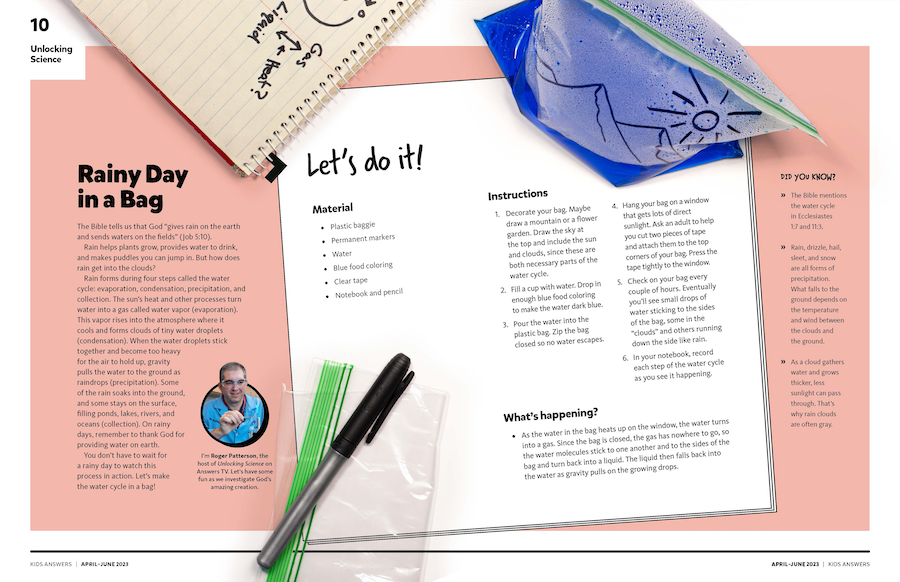Rainy Day in a Bag
Unlocking Science
by Roger Patterson on April 1, 2023The Bible tells us that God “gives rain on the earth and sends waters on the fields” (Job 5:10).
Rain helps plants grow, provides water to drink, and makes puddles you can jump in. But how does rain get into the clouds?

I’m Roger Patterson, the host of Unlocking Science on Answers TV. Let’s have some fun as we investigate God’s amazing creation.
Rain forms during four steps called the water cycle: evaporation, condensation, precipitation, and collection. The sun’s heat and other processes turn water into a gas called water vapor (evaporation). This vapor rises into the atmosphere where it cools and forms clouds of tiny water droplets (condensation). When the water droplets stick together and become too heavy for the air to hold up, gravity pulls the water to the ground as raindrops (precipitation). Some of the rain soaks into the ground, and some stays on the surface, filling ponds, lakes, rivers, and oceans (collection). On rainy days, remember to thank God for providing water on earth.
You don’t have to wait for a rainy day to watch this process in action. Let’s make the water cycle in a bag!
Let’s do it!
Material
- Plastic baggie
- Permanent markers
- Water
- Blue food coloring
- Clear tape
- Notebook and pencil
Instructions
- Decorate your bag. Maybe draw a mountain or a flower garden. Draw the sky at the top and include the sun and clouds, since these are both necessary parts of the water cycle.
- Fill a cup with water. Drop in enough blue food coloring to make the water dark blue.
- Pour the water into the plastic bag. Zip the bag closed so no water escapes.
- Hang your bag on a window that gets lots of direct sunlight. Ask an adult to help you cut two pieces of tape and attach them to the top corners of your bag. Press the tape tightly to the window.
- Check on your bag every couple of hours. Eventually you’ll see small drops of water sticking to the sides of the bag, some in the “clouds” and others running down the side like rain.
- In your notebook, record each step of the water cycle as you see it happening.
What’s happening?
As the water in the bag heats up on the window, the water turns into a gas. Since the bag is closed, the gas has nowhere to go, so the water molecules stick to one another and to the sides of the bag and turn back into a liquid. The liquid then falls back into the water as gravity pulls on the growing drops.
Did you Know?
- The Bible mentions the water cycle in Ecclesiastes 1:7 and 11:3.
- Rain, drizzle, hail, sleet, and snow are all forms of precipitation. What falls to the ground depends on the temperature and wind between the clouds and the ground.
- As a cloud gathers water and grows thicker, less sunlight can pass through. That’s why rain clouds are often gray.
Kids Answers Magazine
Heroes from the Hive
God made honeybees with sensational superpowers.
Browse Kids Issue- © 2025 Answers in Genesis
- Privacy Policy
- Contact
- About


